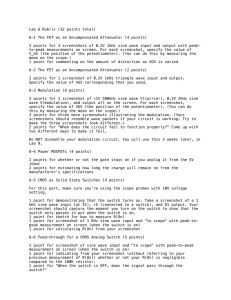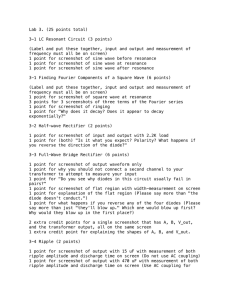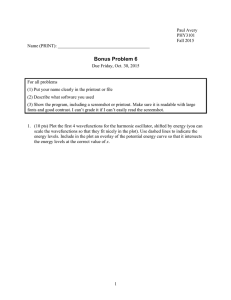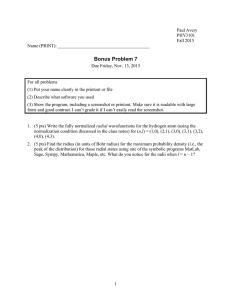Lab 9 Rubric (45 points total)
advertisement
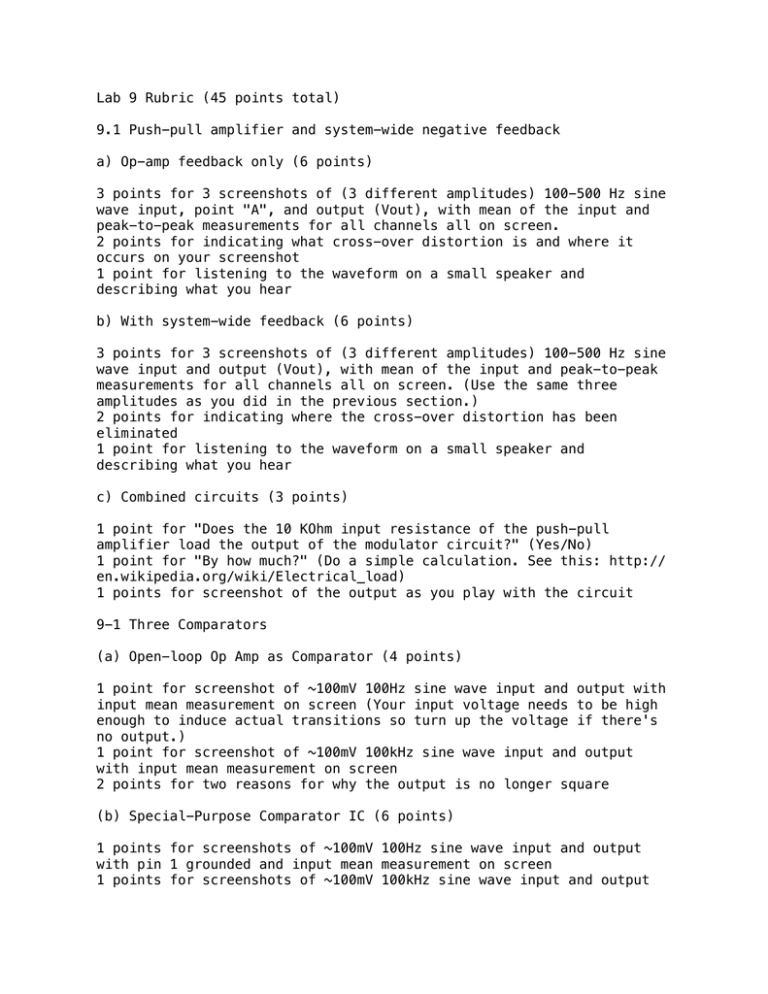
Lab 9 Rubric (45 points total) 9.1 Push-pull amplifier and system-wide negative feedback a) Op-amp feedback only (6 points) 3 points for 3 screenshots of (3 different amplitudes) 100-500 Hz sine wave input, point "A", and output (Vout), with mean of the input and peak-to-peak measurements for all channels all on screen. 2 points for indicating what cross-over distortion is and where it occurs on your screenshot 1 point for listening to the waveform on a small speaker and describing what you hear b) With system-wide feedback (6 points) 3 points for 3 screenshots of (3 different amplitudes) 100-500 Hz sine wave input and output (Vout), with mean of the input and peak-to-peak measurements for all channels all on screen. (Use the same three amplitudes as you did in the previous section.) 2 points for indicating where the cross-over distortion has been eliminated 1 point for listening to the waveform on a small speaker and describing what you hear c) Combined circuits (3 points) 1 point for "Does the 10 KOhm input resistance of the push-pull amplifier load the output of the modulator circuit?" (Yes/No) 1 point for "By how much?" (Do a simple calculation. See this: http:// en.wikipedia.org/wiki/Electrical_load) 1 points for screenshot of the output as you play with the circuit 9-1 Three Comparators (a) Open-loop Op Amp as Comparator (4 points) 1 point for screenshot of ~100mV 100Hz sine wave input and output with input mean measurement on screen (Your input voltage needs to be high enough to induce actual transitions so turn up the voltage if there's no output.) 1 point for screenshot of ~100mV 100kHz sine wave input and output with input mean measurement on screen 2 points for two reasons for why the output is no longer square (b) Special-Purpose Comparator IC (6 points) 1 points for screenshots of ~100mV 100Hz sine wave input and output with pin 1 grounded and input mean measurement on screen 1 points for screenshots of ~100mV 100kHz sine wave input and output with pin 1 grounded and input mean measurement on screen 2 points for comparing the performance of 311 comparator to the 411 op amp (It would be nice if you put the screenshots next to each other in your lab report.) 2 points for zoomed in screenshot of transition oscillation (c) Special-Purpose Comparator IC configured with positive feedback as a Schmitt Trigger (9 points) 2 points for deriving the two thresholds of the circuit (1 for upper, 1 for lower) (1.36V, 0V) 1 point for screenshot of sine wave input and output with pin 1 grounded and input mean measurement on screen (demonstrate that the thresholds are what you predicted) 1 point for screenshot of small sine wave input (just below the critical amplitude) and output with pin 1 grounded and input mean measurement on screen 1 point for explaining why the small input does not trigger 1 point for screenshot of the input independent fluctuations of V-, V +, and Vout 1 point for explaining the fluctuations 1 point for screenshot of large enough sine wave input and output with pin 1 at -15V and input mean measurement on screen 1 point for explaining the purpose of pin 1 9-3 RC Oscillator (5 points) 1 point for calculating the frequency of the oscillator (as it is in Figure 9.6). Show the calculation in your report. (f = 2.623 kHz) 1 point for screenshot of input (point "X") and output (as it is in Figure 9.6) 1 point for calculating the frequency of the oscillator (with the 10K resistor replaced with a 1M resistor). Show the calculation in your report. (f = 108 Hz) 1 point for screenshot of input (point "X") and output (with the 10K resistor replaced with a 1M resistor) 1 point for explaining how the circuit works (Explain in terms of charging and discharging the capacitor.) 9-4 7555 IC Oscillator (6 points) 1 point for screenshot of input (between RB and the capacitor) and output (as it is in Figure 9.5) with peak-to-peak and period measurements on screen 1 point for calculating the period of the circuit (just plug numbers into the already given frequency equation) (2.07 ms or 475.19 Hz) 2 points for checking whether the voltage levels that the capacitor runs between is consistent with the calculated period (Check using a back-of-the-envelope typed calculation or quote a number.) 1 point for screenshot of input (between RB and the capacitor) and output (with RB replaced with a wire) 1 point for explaining the mechanistic difference between RB = 10K and RB = 0.

